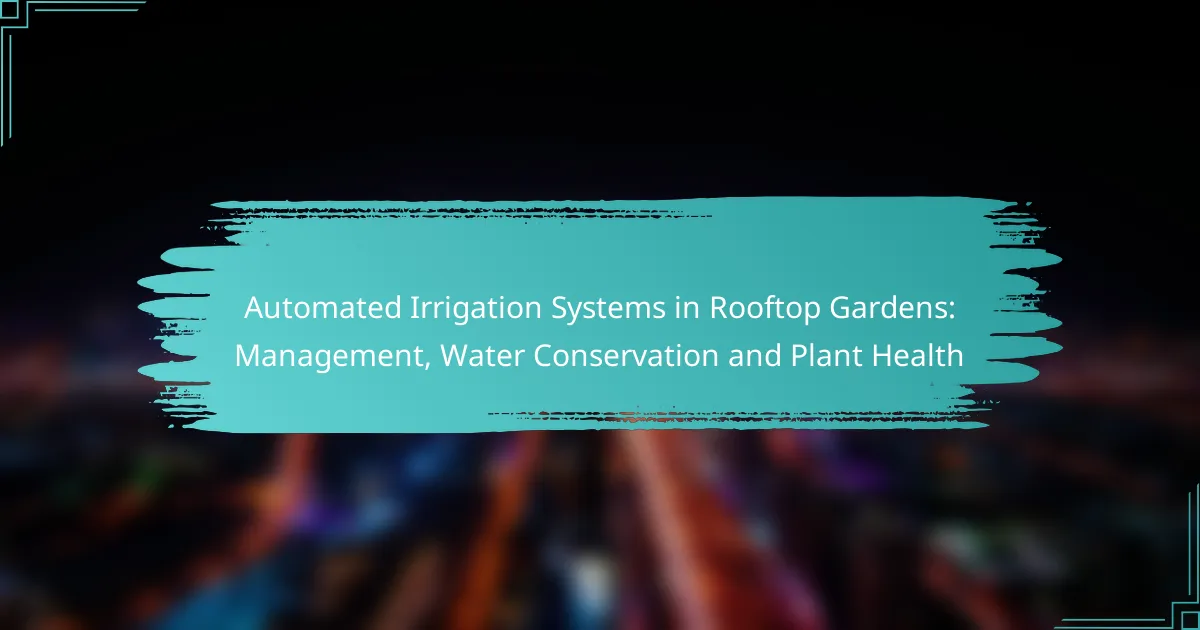Automated irrigation systems in rooftop gardens are essential for promoting efficient water use and enhancing plant health. By utilizing advanced technology, these systems ensure that plants receive the precise amount of moisture needed, significantly reducing water waste and maintenance efforts. With options like drip irrigation and soaker hoses, rooftop gardens can thrive while conserving valuable resources.

What are the benefits of automated irrigation systems in rooftop gardens?
Automated irrigation systems in rooftop gardens offer significant advantages, including efficient water use, healthier plants, and reduced maintenance time. These systems help optimize water delivery, ensuring plants receive the right amount of moisture while conserving resources.
Water conservation
Automated irrigation systems are designed to minimize water waste by delivering precise amounts of water directly to plant roots. This targeted approach can reduce water consumption by up to 50% compared to traditional watering methods. Utilizing sensors that monitor soil moisture levels ensures that irrigation occurs only when necessary, further enhancing conservation efforts.
In urban settings, where water scarcity can be an issue, these systems play a crucial role in sustainable gardening practices. By implementing rainwater harvesting systems in conjunction with automated irrigation, rooftop gardens can significantly decrease their reliance on municipal water supplies.
Improved plant health
Consistent and appropriate watering is vital for plant health, and automated systems excel in providing this. By maintaining optimal soil moisture levels, these systems help prevent overwatering and underwatering, both of which can stress plants and lead to diseases. Healthy plants are more resilient and can better withstand pests and environmental changes.
Additionally, many automated systems can be programmed to deliver nutrients through irrigation, further enhancing plant growth and vitality. This method, known as fertigation, allows for precise nutrient management tailored to specific plant needs.
Time efficiency
Automated irrigation systems save significant time for gardeners by eliminating the need for manual watering. Once set up, these systems can operate on schedules or respond to environmental conditions without further intervention. This allows gardeners to focus on other important tasks, such as planting and maintenance.
For busy urban dwellers, the convenience of automation means they can enjoy a thriving rooftop garden without dedicating extensive time to its upkeep. Regular monitoring and adjustments can be done remotely, making garden management even more efficient.
Cost savings
While the initial investment in an automated irrigation system may be higher than traditional methods, the long-term savings can be substantial. Reduced water bills due to efficient usage can offset installation costs within a few years. Additionally, healthier plants often lead to lower costs associated with pest control and plant replacement.
Moreover, many systems are designed to be energy-efficient, further contributing to overall cost savings. By utilizing solar-powered options, rooftop gardens can minimize energy expenses while maintaining effective irrigation.
Enhanced aesthetics
Automated irrigation systems contribute to the overall aesthetics of rooftop gardens by ensuring plants remain lush and vibrant. Consistent watering promotes healthy growth, resulting in a visually appealing garden that can enhance the ambiance of urban spaces.
Additionally, these systems can be integrated with landscape lighting and other features to create a cohesive and attractive outdoor environment. A well-maintained rooftop garden can also increase property value, making it a worthwhile investment for homeowners and businesses alike.
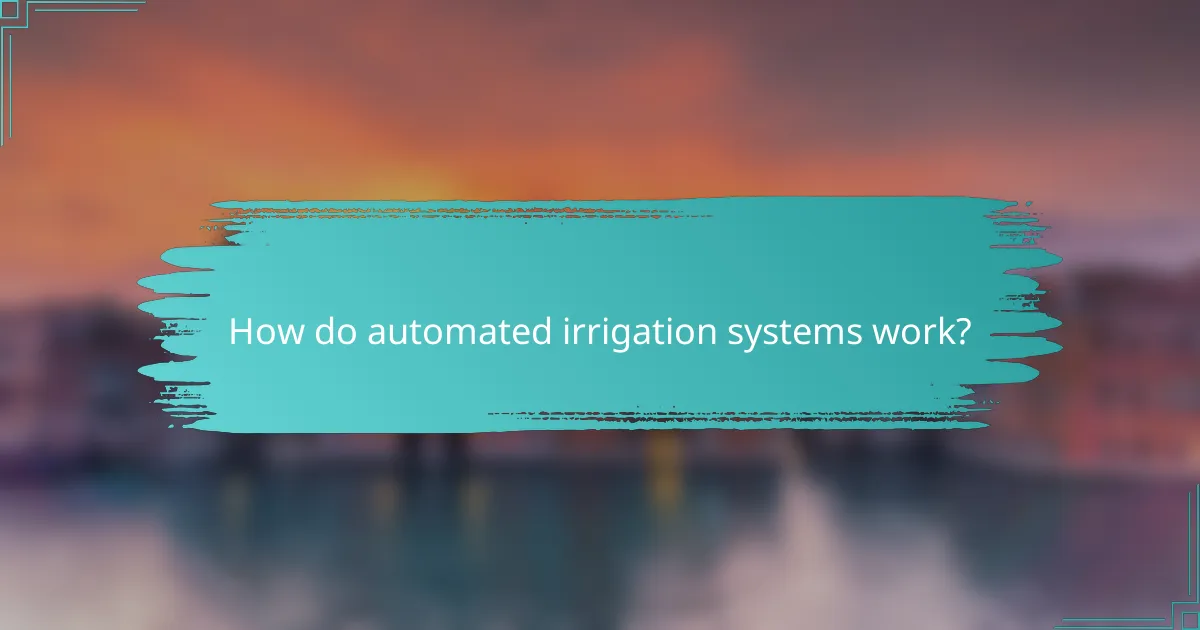
How do automated irrigation systems work?
Automated irrigation systems operate by delivering water to plants based on specific needs, utilizing technology to optimize efficiency and conserve resources. These systems can be programmed or adjusted to ensure that plants receive the right amount of water at the right time, enhancing plant health and reducing waste.
Sensor-based technology
Sensor-based technology is a key component of automated irrigation systems, allowing for real-time monitoring of soil moisture levels. These sensors can detect when the soil is dry and trigger the irrigation system to activate, ensuring that plants receive adequate hydration without overwatering.
Common types of sensors include capacitive and resistive moisture sensors, which vary in cost and accuracy. Investing in high-quality sensors can lead to better water conservation and healthier plants in rooftop gardens.
Timer and scheduling features
Timer and scheduling features allow users to set specific watering times and durations, automating the irrigation process. This can be particularly useful for rooftop gardens, where manual watering may be impractical due to accessibility issues.
Many systems offer customizable schedules, enabling users to adjust watering frequency based on plant types and seasonal changes. A general rule of thumb is to water early in the morning or late in the evening to minimize evaporation.
Integration with weather data
Integrating weather data into automated irrigation systems enhances their efficiency by adjusting watering schedules based on current and forecasted conditions. For instance, if rain is expected, the system can delay watering, conserving water and preventing over-saturation.
Some advanced systems connect to local weather stations or use online weather services to receive real-time updates. This integration can significantly reduce water usage, making it a valuable feature for environmentally conscious gardeners.
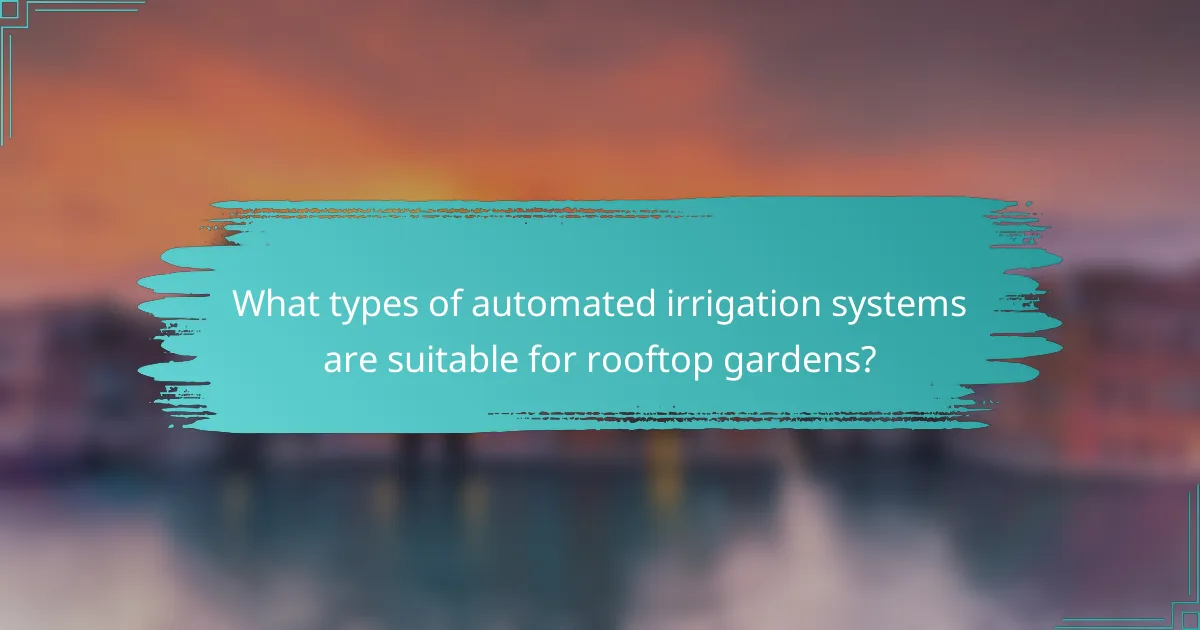
What types of automated irrigation systems are suitable for rooftop gardens?
Rooftop gardens benefit from several automated irrigation systems, each designed to efficiently deliver water while conserving resources. The most suitable options include drip irrigation systems, sprinkler systems, and soaker hoses, each with unique advantages for managing water and supporting plant health.
Drip irrigation systems
Drip irrigation systems deliver water directly to the base of plants through a network of tubing and emitters. This method minimizes water waste by targeting the root zone, making it highly efficient for rooftop gardens where space and water conservation are crucial.
When installing a drip system, consider the layout of your garden and the specific water needs of different plants. Regular maintenance is essential to prevent clogging and ensure even distribution. A timer can be added to automate watering schedules, optimizing water use based on weather conditions.
Sprinkler systems
Sprinkler systems use a network of pipes and spray heads to distribute water over a larger area, making them suitable for more extensive rooftop gardens. They can cover various plant types but may lead to some water loss through evaporation and runoff.
For rooftop applications, select low-pressure or micro-sprinklers to reduce water usage and avoid over-saturation. Ensure that the system is adjustable to accommodate different plant heights and spacing. Regularly check for leaks and blockages to maintain efficiency.
Soaker hoses
Soaker hoses are porous hoses that allow water to seep out slowly along their length, providing a gentle, consistent moisture level to plants. They are easy to install and can be laid out in various configurations to suit your garden’s design.
To use soaker hoses effectively, lay them in a serpentine pattern around your plants and connect them to a water source. A timer can help automate watering times. Be mindful of the hose’s placement to ensure all plants receive adequate moisture without overwatering any specific area.
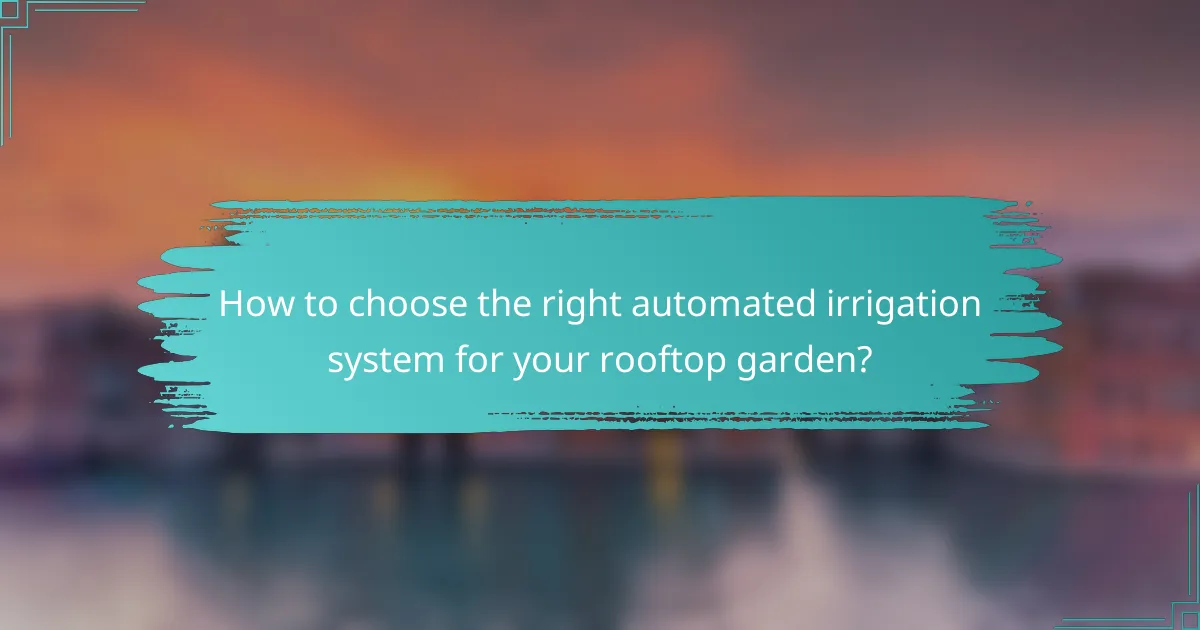
How to choose the right automated irrigation system for your rooftop garden?
Selecting the right automated irrigation system for your rooftop garden involves understanding your garden’s specific needs, including size, plant types, and local climate. A well-chosen system can enhance water conservation and promote healthy plant growth.
Assessing garden size and layout
Your rooftop garden’s size and layout are crucial in determining the appropriate irrigation system. Larger gardens may require more extensive systems with multiple zones, while smaller spaces might benefit from simpler setups.
Consider the layout as well; if your garden has various levels or sections, a drip irrigation system may be ideal for delivering water directly to the roots without waste. Measure your garden area to ensure the system can adequately cover all plants.
Evaluating plant types and water needs
Different plants have varying water requirements, which should influence your choice of irrigation system. For example, succulents and drought-resistant plants need less water compared to tropical plants that thrive in moist conditions.
Group plants with similar water needs together to optimize irrigation efficiency. A smart irrigation system can adjust watering schedules based on the specific needs of each plant type, ensuring healthy growth without overwatering.
Considering local climate conditions
Your local climate significantly impacts the irrigation system you choose. In regions with hot, dry summers, a system that conserves water, such as drip irrigation, is essential. Conversely, in cooler, wetter climates, a more straightforward system might suffice.
Be aware of seasonal changes and rainfall patterns in your area. Utilizing rain sensors can help adjust watering schedules automatically, preventing overwatering during wet months and ensuring plants receive adequate moisture during dry spells.
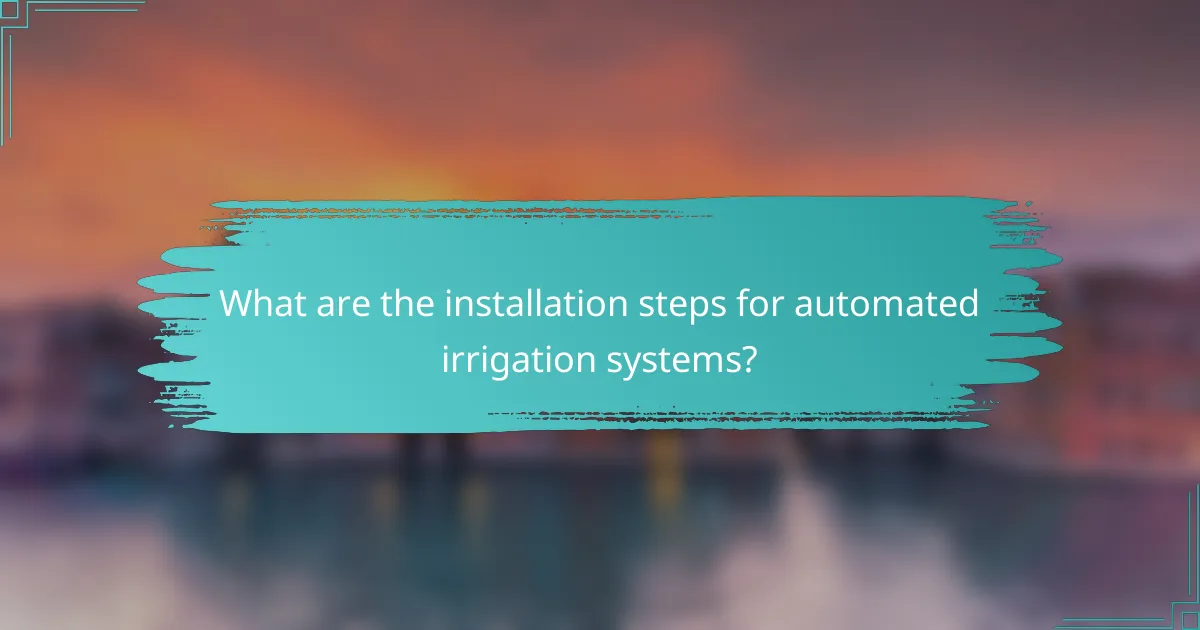
What are the installation steps for automated irrigation systems?
Installing automated irrigation systems involves several key steps to ensure effective water management in rooftop gardens. Proper planning, component installation, and thorough testing are essential to achieve optimal plant health and water conservation.
Planning the irrigation layout
Begin by assessing the garden’s layout, including plant types and their water needs. Create a detailed plan that outlines the placement of irrigation lines, emitters, and control systems to ensure even coverage. Consider factors such as sunlight exposure, wind patterns, and drainage to optimize the system’s efficiency.
Utilize software or design tools to visualize the irrigation layout, which can help in identifying potential issues before installation. A well-planned layout can reduce water waste and enhance plant health by delivering the right amount of moisture to each area.
Installing components
Once the layout is finalized, gather all necessary components, including drip lines, emitters, valves, and a controller. Begin installation by laying out the main lines according to your plan, ensuring they are securely connected and free from kinks. Use stakes or clips to hold the lines in place.
Install emitters at appropriate intervals based on the specific water requirements of each plant type. For example, leafy greens may need more frequent watering than succulents. Ensure that all connections are watertight to prevent leaks, which can lead to water loss and increased costs.
Testing the system
After installation, conduct a thorough test of the entire irrigation system. Turn on the water supply and check for leaks, ensuring that all emitters are functioning correctly and delivering water as planned. Adjust the flow rates if necessary to achieve even distribution across the garden.
Monitor the system over the next few days to identify any areas that may require adjustments. Regular testing and maintenance are crucial for long-term efficiency and plant health, as they help to catch issues before they escalate into larger problems.
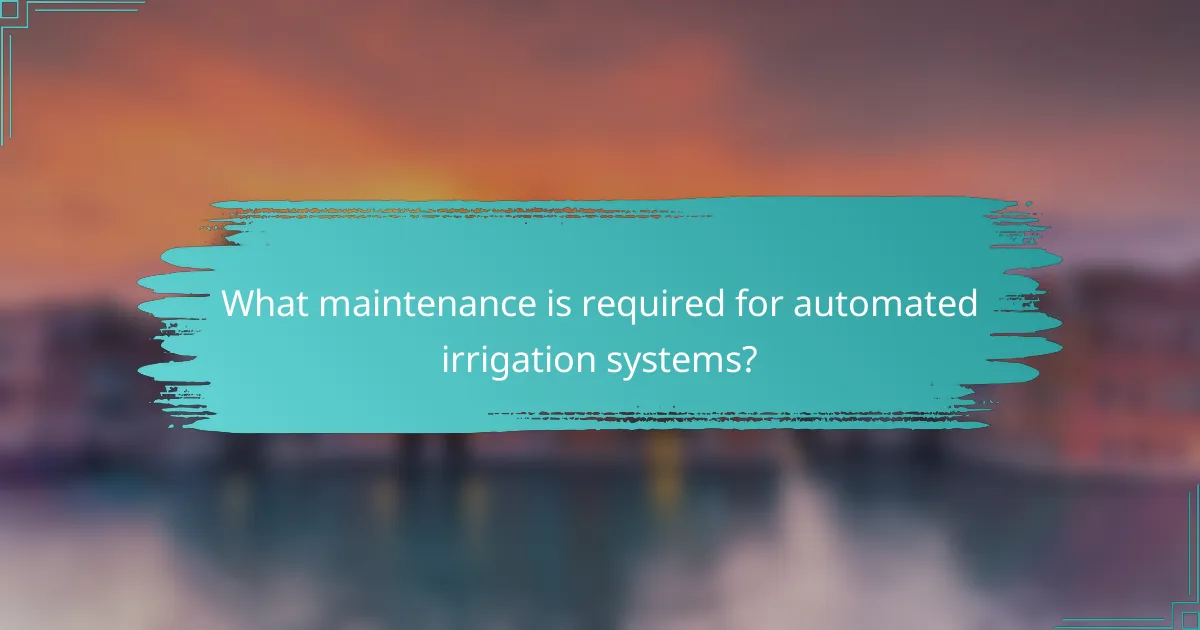
What maintenance is required for automated irrigation systems?
Automated irrigation systems require regular maintenance to ensure optimal performance and longevity. Key tasks include inspections, cleaning, and timely repairs to prevent water waste and maintain plant health.
Regular inspections
Conducting regular inspections is crucial for the effective management of automated irrigation systems. Check for leaks, clogs, and any signs of wear in the components, such as hoses, valves, and emitters. Aim for inspections at least once a month, especially during the growing season.
During inspections, assess the system’s coverage to ensure all areas of the rooftop garden receive adequate water. Adjust sprinkler heads or drip lines as needed to avoid dry spots or overwatering, which can harm plant health.
Cleaning components
Cleaning components of the irrigation system is essential to prevent blockages and ensure efficient water flow. Filters, emitters, and drip lines should be cleaned regularly, ideally every few months, depending on the water quality and system usage.
To clean filters, remove them and rinse with water to eliminate debris. For emitters, use a small brush or compressed air to clear any buildup. Regular cleaning helps maintain water pressure and distribution, promoting healthy plant growth.
Timely repairs
Timely repairs are vital for maintaining the functionality of automated irrigation systems. If you notice any leaks or malfunctioning parts during inspections, address these issues immediately to prevent further damage and water loss.
Keep a basic toolkit on hand for minor repairs, such as replacing worn hoses or fixing broken emitters. For more complex issues, consider consulting a professional to ensure the system operates efficiently and effectively.
